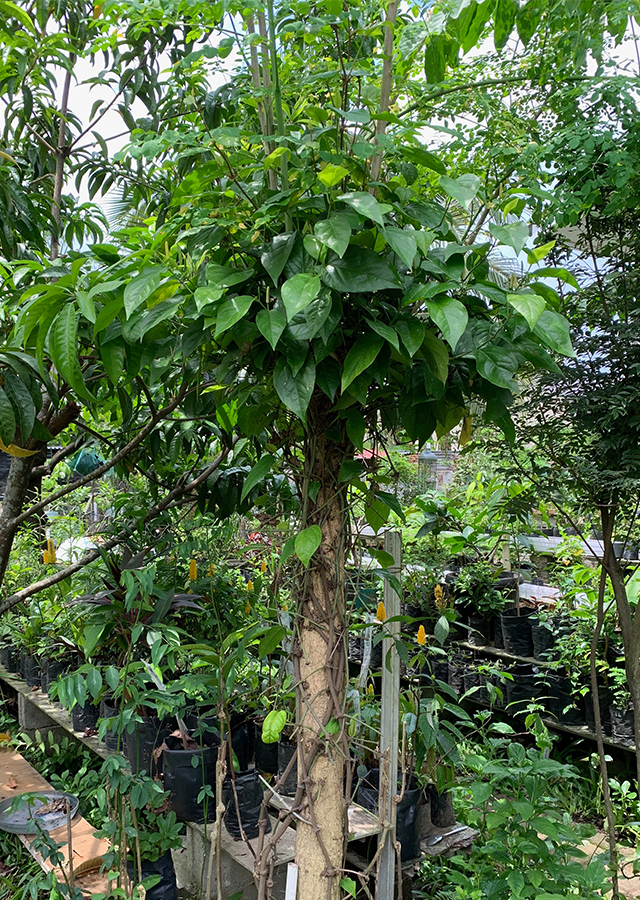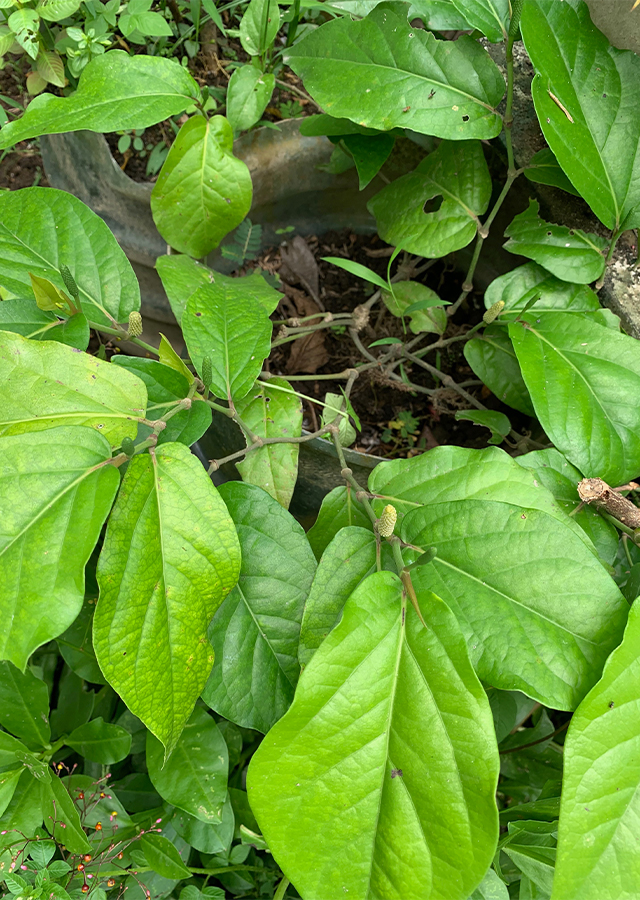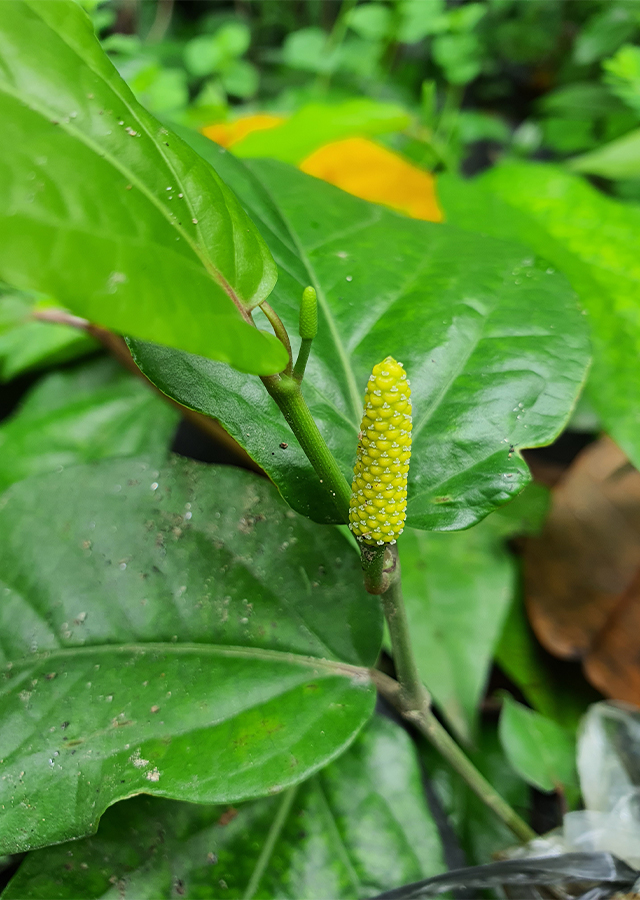Java Long Pepper
Piper retrofractum Vahl
Piperaceae
Location in our garden
Green House



Synonym
Amalago antillana Raf.
Cubeba chaba (W.Hunter) Miq.
Piper parvifolium Blanco
Habitus
Climbers. An evergreen, deciduous vine, growing to a height of 2 to 4 m
Part Used
Leaves
Fruit
Roots
Growing Requirements
Full Sunshine
Need Shade
Habitat
Rocky Areas
Shrublands
Grassland
Overview
Java long pepper also known as Balinese pepper, native to Bangladesh to China (Yunnan), and West and Central Malesia including Java, Indonesia. The plant is gathered from the wild for mainly local use as a condiment and medicinal herb. Leaves and berries of this pepper are edible, also ripe and unripe fruits used as spice. The wood and root are the source of a dye.
Vernacular Names
Cabe jawa (Indonesia), Jia bi ba (Chinese), Dei phei (Cambodian), Dei phei (Korean), Dee Plee (Thai), Poivre long de Java (French), Javaanse lange peper (Dutch), Litlit (Tagalog-Philippines), Lada panjang (Malay), Makropiperi (Greek).
Agroecology
This plant is common thickets at low elevations. It can grow in land with an altitude of 0-600 m above sea level. Grows in area with the rainfall of 1,259-2,500 mm per year. This plant has the advantage of being able to grow on dry land. It is good growing in sandy loam soil and well drained,.
Morphology
- Roots - has main root with a lot of lateral roots.
- Stems - smooth and the bracts are stalkless and peltate.
- Leaves - short-petioled, pale when dry, oblong, oblong-ovate, or elliptic lanceolate, 6 to 7.5 cm long, 3 to 8 cm wide, papery; the base sublateral or inequilateral, pointed or slightly heart-shaped and the apex pointed; penninerved, the lateral nerves 7 to 11 on each side of the midrib, ascending.
- Flowers - male spikes are 3.8 to 8.5 cm long, 2.5 to 4.5 mm in diameter; the bracts somewhat stalked, and peltate. Stamens are 2 to 3, stalkless. Female spikes are oblong when mature, red fleshy and cylindrical, 3 to 6.5 cm long, 6.5 to 11 mm in diameter.
- Fruits - more or less united, partly or wholly embedded in and concrescent with the rachis. Stigmas are three and short.
- Seeds - subglobose to obovoid-globose, 2 to 2.5 mm long.
Cultivation
Generative propagation through seeds.
Chemical Constituents
Roots: piperine, piperartine, piperlonguminine. Fruits: piperine, chavicine, palmitic acids, 1-undecylenyl-3, 4-methylenedioxy benzene, piperidin, essential oils, Isobutyideka-trans-2-trans-4-dienamide, sesamin guineensine, piperoctadecalidine.
Traditional Medicinal Uses
- Studies have suggested larvicidal, antioxidant, cardioprotective, anti-inflammatory, anti-convulsant, anti-dengue, aphrodisiac, anticancer, antidepressant, antibacterial, antifungal, anti-lice properties, and immunomodulator.
- The fruits have been used for their anti-flatulent, expectorant, antitussive, and appetizing properties.
- Root is chewed and the saliva swallowed, or the decoction of root taken internally as cure for colic, dyspepsia and gastralgia.
- For postpartum fevers and chills, a handful of leaves are salted and oiled, then heated over embers and stroked over the entire body, from head to foot.
- In China, used for vomiting, hiccups, stomachaches, diarrhea due to coldness in the stomach. For toothaches, applied externally.
- In Bangladesh, plants are used to cure rheumatic pain and body pain after childbirth. Fruits are used for coughs, colds, asthma, bronchitis, fever, hemorrhoids.
- In Ayurvedic and Unani systems of medicine, the fruit's hot flavor is used for improving digestion, blood circulation, and overall health; to treat influenza, and hypertension, and as an antiflatulent.
- In Indonesian traditional medicine, used to improve stamina and for its aphrodisiac effect and beneficial effect on erectile dysfunction.
Part Used
Reference Sources
- Fern, Ken. (2019). Useful Tropical Plants. Piper retrofractum. http://tropical.theferns.info/viewtropical.php?id=Piper+retrofractum. 23-02-2021.
- Gourment Food World. (No date). Long Pepper. https://www.gourmetfoodworld.com/long-pepper-1773. 23-02-2021.
- Kim, K.J., Lee, M.S., and Hwang, J.K.(2011). Piperidine alkaloids from Piper retrofractum Vahl. protect against high-fat diet-induced obesity by regulating lipid metabolism and activating AMP-activated protein kinase. https://www.sciencedirect.com/science/article/abs/pii/S0006291X11011521. 23-02-202.
- StuartXchange. (2015). Philippines Medicinal Plants: Litlit (Piper retrofractum Vahl.) http://www.stuartxchange.org/Litlit.html. 23-02-2021.


